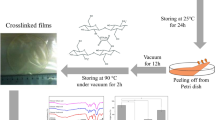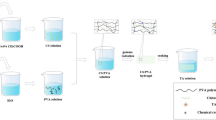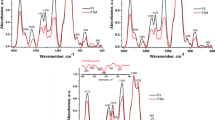Abstract
Novel interactive and thermoresponsive interpenetrating polymer network (IPN) films, which are transparent, permeable to oxygen, and have the potential to be easily stripped from a wound bed, were synthesised using rapid photopolymerisation and crosslinking of DEAAm in the presence of chitosan. This study provides the first evaluation and optimisation of a UV-polymerised chitosan–PDEAAm IPN composite film for application in wound dressings. FTIR spectroscopy and DSC analysis were used to initially characterise the resulting films. Modulated differential scanning calorimetry results showed that the dressings exhibited lower critical solution temperatures in the desired range, while the samples were also observed to undergo temperature-dependent swelling behaviour. This thermosensitive property would potentially allow the dressings to be easily detachable, which would enable frequent dressing changes if desired without causing further injury to healing tissues. Furthermore, the water content values recorded are in the typical and desired ranges for commercial wound dressings.






Similar content being viewed by others
References
Murakami K, Aoki H, Nakamura S, Nakamura S-I, Takikawa M, Hanzawa M, Kishimoto S et al (2010) Hydrogel blends of chitin/chitosan, fucoidan and alginate as healing-impaired wound dressings. Biomaterials 31:83–90
Sung JH, Hwang MR, Kim JO, Lee JH, Kim YI, Kim JH, Chang SW, Jin SG, Kim JA, Lyoo WS, Han SS, Ku SK, Yong CS, Choi HG (2010) Gel characterisation and in vivo evaluation of minocycline-loaded wound dressing with enhanced wound healing using polyvinyl alcohol and chitosan. Int J Pharm 392:232–240
Hollinworth H, Collier M (2000) Nurses’ views about pain and trauma at dressing changes: results of a national survey. J Wound Care 9(8):369–373
Lin S-Y, Chen K-S, Chu L-R (2001) Design and evaluation of drug-loaded wound dressing having thermoresponsive, adhesive, absorptive and easy peeling properties. Biomaterials 22:2999–3004
Chen K-S, Ku Y-A, Lee C-H, Lin H-R, Lin F-H, Chen T-M (2005) Immobilisation of chitosan gel with cross-linking reagent on PNIPAAm gel/PP nonwoven composites surface. Mater Sci Eng C 25:472–478
Yang JM, Yang SJ, Lin HT, Wu T-H, Chen H-J (2008) Chitosan containing PU/Poly(NIPAAm) thermosensitive membrane for wound dressing. Mater Sci Eng C 28:150–156
Radhakumary C, Antonty M, Sreenivasan K (2011) Drug loaded thermoresponsive and cyto-compatible chitosan based hydrogel as a potential wound dressing. Carbohydr Polym 83:705–713
Chen J-P, Kuo C-Y, Lee W-L (2012) Thermoresponsive wound dressings by grafting chitosan and poly(N-isopropylacrylamide) to plasma-induced graft polymerization modified non-woven fabrics. Appl Surf Sci. doi:10.1016/j.apsusc.2012.02.106
Kim J, Cai Z, Lee HS, Choi GS, Lee DH, Jo C (2011) Preparation and characterization of a bacterial cellulose/chitosan composite for potential biomedical application. J Polym Res 18(4):739–744
Mourya VK, Inamdar NN (2008) Chitosan modifications and applications: opportunities galore. React Funct Polym 68:1013–1051
Muzzarelli RAA (2009) Chitins and chitosans for the repair of wounded skin, nerve, cartilage and bone. Carbohydr Polym 76:167–182
Jayakumar R, Prabaharan M, Kumar PT, Sudheesh NSV, Tamura H (2011) Biomaterials based on chitin and chitosan in wound dressing applications. Biotechnol Adv 29:322–337. doi:10.1016/j.biotechadv.2011.01.005
Shi CM, Zhu Y, Ran XZ, Wang M, Su Y, Cheng TM (2006) Therapeutic potential of chitosan and its derivatives in regenerative medicine. J Surg Res 133:185–192
Ngadaonye JI, Geever LM, Cloonan MO, Higginbotham CL (2012) Photopolymerised thermo-responsive poly(N,N-diethylacrylamide)-based copolymer hydrogels for potential drug delivery applications. J Polym Res 19:9822
Okano T, Bae YH, Jacobs H, Kim SW (1990) Thermally on-off switching polymers for drug permeation and release. J Controlled Release 11:255–265
Okuyama Y, Yoshida R, Sakai K, Okano T, Sakurai Y (1993) Swelling controlled zero order and sigmoidal drug release from thermo-responsive poly(N-isopropylacrylamide-co-butyl methacrylate) hydrogel. J Biomater Sci Polym Ed 4:545–556
Kim SJ, Lee CK, Lee YM, Kim SI (2003) Preparation and characterisation of thermosensitive poly(N-isopropylacrylamide)/poly(ethylene oxide) semi-interpenetrating networks. J Appl Polym Sci 90:3032–3036
Zhang JT, Huang SW, Liu J, Zhuo RX (2004) Temperature sensitive poly(N-isopropyl acrylamide)/poly(N-isopropylacrylamide) interpenetrating polymer networks for drug delivery. J Polym Sci Polym Chem 42:1249–1254
Deshpande DS, Bajpai R, Bajpai AK (2012) Synthesis and characterization of polyvinyl alcohol based semi interpenetrating polymeric networks. J Polym Res 19:9938
Yun J, Im JS, Kim HI, Lee YS (2012) Effect of oxyfluorination of PVA/PNIPAAm hydrogel on temperature responsive drug release. J Polym Res 19:9887
Yang JM, Lin HT (2004) Properties of chitosan containing PP-g-AA-g-NIPAAm bigraft nonwoven fabric for wound dressing. J Membr Sci 243:1–7
Panayiotou M, Pöhner C, Vandevyver C, Wandrey C, Hilbrig F, Freitag R (2007) Synthesis and characterisation of thermoresponsive poly(N,N-diethylacrylamide) microgels. React Funct Polym 67:807–819
Akturk O, Tezcaner A, Bilgili H, Deveci MS, Gecit MR, Keskin D (2011) Evaluation of sericin/collagen membranes as prospective wound dressing biomaterial. J Biosci Bioeng 112:279–288
Sakchai W, Chureerat P, Srisagul S (2006) Development and in vitro evaluation of chitosan- eudragit RS 300 composite wound dressings. AAPS Pharm Sci Tech 7:E1–E6
Ganji F, Abdekhodaie MJ (2010) Chitosan-g-PLGA copolymer as a thermosensitive membrane. Carbohydr Polym 80:740–746
Yang C, Xu L, Zhou Y, Zang X, Huang X, Wang M, Han Y, Zhai M, We S, Li J (2010) A green fabrication approach of gelatin/CM-chitosan hybrid hydrogel for wound healing. Carbohydrate Polym 82:1297–1305
Abugoch LE, Tapia C, Villamán MC, Yazdani-Pedram M, Díaz-Dosque M (2011) Characterisation of quinoa protein–chitosan blend edible film. Food Hydrocolloids 25:879–886
Brugnerotto J, Lizardi J, Goycoolea FM, Arguelles-Monal W, Desbrieres J, Rinaudo M (2001) An infrared investigation in relation with chitin and chitosan characterisation. Polymer 42(8):3569–3580
Prashanth KVH, Kittur FS, Tharanathan RN (2002) Solid state structure of chitosan prepared under different N-deacetylating conditions. Carbohydrate Polym 50(1):27–33
Brandenburg K, Seydel U (1996) Fourier transform infrared spectroscopy of cell surface polysaccharides. Wiley–Liss, New York
Lima CGA, de Oliveira RS, Figueiro SD, Wehmann CF, Goes JC, Sombra ASB (2006) DC conductivity and dielectric permittivity of collagen–chitosan films. Mater Chem Phys 99:284–288
Chen J, Liu M, Liu H, Ma L (2009) Synthesis, swelling and drug release behaviour of poly(N,N-diethylacrylamide-co-N-hydroxymethyl acrylamide) hydrogel. Mater Sci Eng C 29:2116–2123
Cerqueira M, Souza B, Teixeira J, Vicente A (2011) Effect of glycerol and corn oil on physico-chemical properties of polysaccharide films—a comparative study. Food Hydrocoll 27:175–184
Brown CD, Kreilgaard L, Nakakura M, Caram-Lelham N, Pettitb DK, Gombotzb WR et al (2001) Release of PEGylated granulocyte–macrophage colony stimulating factor from chitosan/glycerol films. J Controlled Release 72:35–46
Lavorgna M, Piscitelli F, Mangiacapra P, Buonocore GG (2010) Study of the combined effect of both clay and glycerol plasticiser on the properties of chitosan films. Carbohydr Polym 82:291–298
Mucha M, Pawlak A (2005) Thermal analysis of chitosan and its blends. Thermochima Acta 427:69–76
Lazaridou A, Biliaderis CG (2002) Thermophysical properties of chitosan, chitosan–starch and chitosan–pellulan films near the glass transition. Carbohydr Polym 48:179–190
Hasegawa M, Isogai F, Onabe F, Usuda M, Atalla RH (1992) Characterisation of cellulose–chitosan blend films. J Appl Polym Sci 45:1873–1879
Czihak C, Muller M, Schober H, Heux L, Vogl G (1999) Dynamics of water adsorbed to cellulose. Physica B 266:87–91
Sakurai K, Maegawa T, Takahashi T (2000) Glass transition temperature of chitosan and miscibility of chitosan/poly(N-vinyl pyrrolidone) blends. Polymer 41:7051–7056
Silva CL, Pereira JC, Ramalho A, Pais ACC, Sousa JJS (2008) Films based on chitosan polyelectrolyte complexes for skin delivery: Development and characterisation. J Membr Sci 320:268–279
Shanta K, Harding DRK (2002) Synthesis and characterisation of chemically modified chitosan microspheres. Carbohydr Polym 48:247–253
Dong Y, Ruan Y, Wang H, Zhao Y, Bi D (2004) Studies on glass transition temperature of chitosan with four techniques. J Appl Polym Sci 93:1553–1558
Suyatma NE, Tighzert L, Copinet A, Coma V (2005) Effects of hydrophilic plasticisers on mechanical, thermal, and surface properties of chitosan films. J Agric Food Chem 53:3950–3957
Diab T, Biliaderis CG, Gerasopoulos D, Sfakiotakis E (2001) Physicochemical properties and application of pullulan edible films and coatings in fruit preservation. J Sci Food Agric 81:988–1000
Olivas GI, Barbosa-Cánovas GV (2008) Alginate–calcium films: water vapour permeability and mechanical properties as affected by plasticiser and relative humidity. LWT—Food Sci Technol 41:359–366
Silva MESR, Dutra ER, Mano V, Machado JC (2000) Polym Degrad Stab 67:491–495
Idziak I, Avoce D, Lessard D, Gravel D, Zhu XX (1999) Thermosensitivity of aqueous solutions of poly(N,N-diethylacrylamide). Macromolecules 32:1260–1263
Liu H, Liu M, Ma L, Chen J (2009) Thermo- and pH-sensitive comb-type grafted poly(N,N-diethylacrylamide-co-acrylic acid) hydrogels with rapid response behaviours. Eur Polym J 45:2060–2067
Witthayaprapakorn C (2011) Design and preparation of synthetic hydrogels via photo-polymerisation for biomedical use as wound dressings. Procedia Eng 8:286–291
Kichofen B, Wokalek H, Scheel D, Ruh H (1986) Chemical and physical properties of a hydrogel wound dressing. Biomaterials 7:67–72
Winkler LW (1888) Die Bestimmung des in Wasser gelösten Sauerstoffen. Be Dtsch Chem Ges 21:2843–2855
Strickland JDH, Parsons TR (1968) Determination of dissolved oxygen. A practical handbook of seawater analysis. Bull Fisheries Res Board Canada 167:71–75
Wittaya-areekul S, Prahsarn C (2006) Development and in vitro evaluation of chitosan polysaccharides composite wound dressings. Int J Pharm 313:123–128
Silver IA (1972) Oxygen tension and epithelialisation. In: Maibach HI, Rovee DT (eds) Epidermal wound healing. Year Book Medical, Chicago, p 291
Winter GD (1972) Epidermal regeneration studied in the domestic pig. In: Maibach HI, Rovee DT (eds) Epidermal wound healing. Year Book Medical, Chicago, p 71
Pandit AS, Faldman DS (1994) Effect of oxygen treatment and dressing oxygen permeability on wound healing. Wound Repair Regen 2(2):130–137
Acknowledgements
This study was supported in part by grants from both the Irish Department of Education (Core Research Strengths Enhancement—Technological Sector Research: Strand III) and the Athlone Institute of Technology research and development fund.
Author information
Authors and Affiliations
Corresponding author
Rights and permissions
About this article
Cite this article
Ngadaonye, J.I., Geever, L.M., Killion, J. et al. Development of novel chitosan-poly(N,N-diethylacrylamide) IPN films for potential wound dressing and biomedical applications. J Polym Res 20, 161 (2013). https://doi.org/10.1007/s10965-013-0161-1
Received:
Accepted:
Published:
DOI: https://doi.org/10.1007/s10965-013-0161-1




